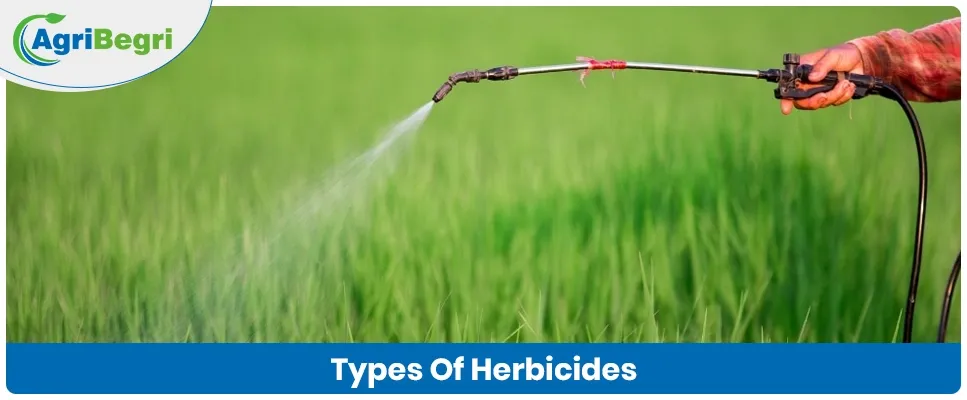Introduction:
Earlier, when chemicals and tools weren’t developed to clear land, we controlled weeds by removing them manually. Today, chemicals called herbicides have made it simple. Herbicides play an important role in modern-day farming. These chemicals help farmers in managing weeds effectively and promote crop growth, quality, and yield.
Since weeds compete with crops for nutrition, water, and sunlight, it's crucial to remove them. However, there is a broad range of herbicides available in the market, and therefore, it's also required to understand the types of herbicides and their use on crops. Here’s the ultimate guide that can help farmers and gardeners understand herbicide types and usage.
What are Herbicides?
Herbicides are chemicals or natural compounds used to control or completely eradicate weeds. Their usage ensures that the commercial crop has uninterrupted growth.
The role of different types of herbicides is essential, as they reduce the labor costs associated with manual weeding. Both organic and synthetic herbicides are used in modern agriculture, depending on the farming system.
Types of Herbicides Based on Selectivity (Selective Vs. Non-Selective)
Selective Herbicides:
These are the types of herbicides designed to control or remove only weeds. Since these herbicides are safe for crops, they are widely used. They work on specific plant families or plant species.
Example:
- 2,4-Dichlorophenoxyacetic acid. It is commonly applied in wheat fields to control broadleaf weeds, such as Chenopodium and Amaranthus.
- Pendimethalin is a selective herbicide that targets grassy weeds in soybean, cotton, and groundnut cultivation.
If the crops are sensitive to chemical damage, then selective herbicides and it's targeted weed control is perfect for you. They are precise, which is a huge advantage, but remember that overuse can also cause harm.
Non-Selective Herbicides:
Non-selective herbicides kill almost all plants with which they come into physical contact. Whether a commercial crop or a weed, a non-selective herbicide will finish it off.
If you want to clear weeds only on the boundaries of your field and irrigation paths, or clear out the entire field before the new season, then a non-selective herbicide is your best tool.
Example:
- Glyphosate is one of the most widely used non-selective herbicides, applied before sowing to clear out any underlying weeds in the soil.
- Paraquat is used to quickly burn weeds in coffee or tea plantations. These should be applied with extreme caution, as even slight carelessness or an accident can cause significant damage to the standing commercial crop, resulting in yield loss.
Types of Herbicides Based on Application Timing (Pre- vs. Post-Emergent)
Pre-Emergent Herbicides:
Pre-emergent herbicide is applied before the weeds can germinate. These types of herbicides form a chemical barrier within the soil that stops weeds from sprouting. The first wave of weeds that can potentially compete with the commercial crop during its early growth stage requires a pre-emergent herbicide for effective control.
Example:
- Pendimethalin (Pre-emergent) is used in the cultivation of soybeans, cotton, and groundnuts. It is applied immediately after the sowing phase to prevent grassy weeds from germinating.
- Oxadiargyl is another pre-emergent herbicide applied in paddy fields to control grassy and sedge weeds.
These pre-emergents save a lot of labor costs. However, the timing of their application is extremely critical, where delays have notably reduced their effectiveness.
Post-Emergent Herbicide:
As their name suggests, post-emergents are used after the weeds have already sprouted and are visible. These herbicides target weeds that have emerged and are actively growing. Moreover, they work when pre-emergents are missed or are less effective.
Example:
- 2,4-D can control broadleafs in wheat
- Quizalofop-ethyl controls the grassy weed Echinochloa in soybeans.
- Fenoxaprop-p-ethyl is commonly applied in rice to target grassy weeds.
You can combine a pre- and post-emergent in a strategic application for a weed control that lasts an entire season.
Weeds can be a menace if left untreated. They compete with the commercial crop for resources like nutrients, water, sunlight, and space. They can cut down 20% to 40% of your yield and profit. Weeds can affect your yield adversely if you're cultivating crops like paddy, wheat, maize, soybean, cotton, and pulses.
Contact-based Herbicides
A herbicide that kills the plant upon a touch is called contact herbicide. They act only on plant surfaces and do not move inside the weed. Therefore, proper spray that covers all the areas is necessary.
Contact herbicides act fast, but if the underground roots of a weed remain untouched, then there are high chances that the weed may grow in the future.
Example:
- Paraquat and Oxyfluorfen. Paraquat is a fast-acting herbicide that can burn weeds within hours of application and is widely used in plantation crops.
- Oxyfluorfen is used in garlic, onion, and cotton fields as a measure against broadleaf weeds. You should consider contact herbicides when you need rapid control or a quick action in the inter-rows.
Systemic-based Herbicides
These types of herbicides are absorbed by leaves or roots, and then they are transported throughout the plant’s internal system. This action ensures that rhizomes, tubers, and stolons that exist underground, are also destroyed. This prevents regrowth more effectively than contact herbicides.
Example:
- Glyphosate and 2,4-D can be considered as systemic-based herbicides. Glyphosate is absorbed by leaves and transported into the roots, making it effective against perennial weeds like Cynodon dactylon, commonly known as Bermuda grass. 2,4-D is a widely used systemic herbicide for sugarcane and wheat.
They are dependable for long-term weed control but are slow in showing results as compared to contact herbicides.
Herbicide Types with Examples in Major Crops
Choosing your preferences for the types of herbicides requires a good understanding of parameters such as crop, growth stages, and weed types.
Let's examine the detailed correlation between crops and herbicides, along with the specifications of weeds.
|
Crops
|
Herbicides
|
Weed Control
|
|
Rice
|
Pre-emergent herbicide
|
Grassy weed
|
|
Wheat
|
2,4-D and Metsulfuron-methyl
|
Broadleaf weed
|
|
Cotton
|
Pendimethalin (Pre-emergent herbicide)
Oxyfluorfen (Post-emergent herbicide)
Quizalofop-ethyl (Post-emergent herbicide)
|
Annual weed,
Grassy weed,
Broad-leaf weed
|
|
Maize
|
Atrazine (Selective herbicide)
|
Broadleaf & Grassy weed
|
|
Soybeans
|
Pendimethalin (Pre-emergent herbicide)
Quizalofop-ethyl (Post-emergent herbicide)
|
Annual grass and broad-leaf weed
|
Herbicides are not limited to these crops only; you can use broad–spectrum herbicides like Glyphosate for crops like tea, coffee, and mango orchards.











